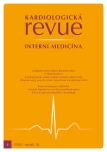Hypertension in pregnancy
Authors:
Vysočanová M.; Floriánová A.; Špinar J.
Authors‘ workplace:
Interní kardiologická klinika LF MU a FN Brno
Published in:
Kardiol Rev Int Med 2018, 20(4): 251-255
Overview
Hypertension complicates 5–10% of pregnancies and is responsible for substantial maternal/foetal and neonatal morbidity and mortality. Although not uniform, the preferred definition is based on absolute blood pressure (BP) values (systolic BP ≥ 140 or diastolic BP ≥ 90 mmHg). Hypertension in pregnancy is divided into 4 categories: pre-existing hypertension, gestational hypertension, pre-existing hypertension with superimposed gestational hypertension with proteinuria and unclassifiable hypertension. Non-pharmacological treatment of hypertension should be considered in women with BP of 140–150/90–99 mmHg. Salt restriction or weight reduction is not recommended. Pharmacological treatment is recommended in all pregnant women with BP ≥ 150/95. Antihypertensive treatment should be considered at values ≥ 140/90 mmHg in women with gestational hypertension, pre-existing hypertension with superimposed gestational hypertension or hypertension with target organ damage. Methyldopa, calcium-channel blockers and beta-blockers are drugs of choice. ACE inhibitors and AT1 blockers, spironolactone and atenolol are contraindicated in pregnancy. Intravenous labetalol can be given for severe and complicated hypertension. Drugs of second choice in hypertensive emergencies are nitroprusside IV, or IV urapidil. All antihypertensive drugs taken by nursing mothers are excreted into breast milk, but most of them are present at very low concentrations. Hypertension in pregnancy is a marker for future cardiovascular and metabolic diseases.
Key words:
hypertension – pregnancy – gestational hypertension – pre-eclampsia
Sources
1. Widimský J, Filipovský J, Ceral J et al. Doporučení pro diagnostiku a léčbu arteriální hypertenze ČSH 2017. Hypertenze a kardiovaskulní prevence 2018; (suppl): 1– 19.
2. Black MH, Zhou H, Sacks DA et al. Hypertensive disorders first identified in pregnancy increase risk for incident prehypertension and hypertension in the year after delivery. J Hypertens 2016; 34(4): 728– 735. doi: 10.1097/ HJH.0000000000000855.
3. Český statistický úřad. Vývoj českého obyvatelstva v r. 2017. Porodnost a plodnost: 18– 24. Dostupné na: https:/ / www.czso.cz/ csu/ czso/ vyvoj-obyvatelstva-ceske-republiky-2017.
4. Wang YA, Chughtai AA, Farquhar CM et al. Increased incidence of gestational hypertension and preeclampsia after assisted reproductive technology treatment. Fertil Steril 2016; 105(4): 920– 926. doi: 10.1016/ j.fertnstert.2015.12.024.
5. Brown MA, Magee LA, Kenny LC et al. Hypertensive disorders of pregnancy: ISSHP classification, diagnosis, and management recommendations for international practice. Hypertension 2018; 72(1): 24– 43. doi: 10.1161/ HYPERTENSIONAHA.117.10803.
6. Regitz-Zagrosek V, Roos-Hesselink JW, Bauersachs J et al. 2018 ESC Guidelines for the management of cardiovascular diseases during pregnancy. Eur Heart J 2018; 39(34) 3165– 3241. doi: 10.1093/ eurheartj/ ehy340.
7. Vlk R, Procházka M. Hypertenzní onemocnění v těhotenství. Doporučený postup České gynekologické a porodnické společnosti. Čes Gynek 2018; 83(2): 145– 154.
8. Tucker KL, Taylor KS, Crawford C et al. Blood pressure self-monitoring in pregnancy: examining feasibility in a prospective cohort study. BMC Pregnancy Childbirth 2017; 17(1): 442. doi: 10.1186/ s12884-017-1605-0.
9. Linhart A, Ceral J, Filipovský J. Praktický postup České společnosti pro hypertenzi. Měření krevního tlaku. Hypertenze a kardiovaskulární prevence 2016; 5: 24– 33.
10. Bello NA, Woolley JJ, Cleary KL et al. Accuracy of blood pressure measurement devices in pregnancy: a systematic review of validation studies. Hypertension 2018; 71(2): 326– 335. doi: 10.1161/ HYPERTENSIONAHA.117.10295.
11. Shabazian N, Shabazian H, Mohammadjafari R et al. Ambulatory monitoring of blood pressure and pregnancy outcome in pregnant women with white coat hypertension in the third trimester of pregnancy. J Nephropharmacol 2013; 2(1): 5– 9.
12. Cífková R. Hypertenze v těhotenství. Čas Lék čes 2009; 148: 65– 71.
13. Bramham K, Parnell B, Nelson-Piercy C et al. Chronic hypertension and pregnancy outcomes: systematic review and meta-analysis. BMJ 2014; 348: g2301. doi: 10.1136/ bmj.g2301.
14. Magee LA, von Dadelszen P, Singer J et al. The CHIPS randomized controlled trial (Control of Hypertension in Pregnancy Study): Is severe hypertension just an elevated blood pressure? Hypertension 2016; 68(5): 1153– 1159. doi: 10.1161/ HYPERTENSIONAHA.116.07862.
15. Nakhai-Pour HR, Rey E, Berard A. Discontinuation of antihypertensive drug use during the first trimester of pregnancy and the risk of preeclampsia and eclampsia among women with chronic hypertension. Am J Obstet Gynecol 2009; 201(2): 180.e1–e8. doi: 10.1016/ j.ajog.2009.05.019.
16. Cooper WO, Hemandez-Diaz S, Arbogast PG et al. Major congenital anomalies after first – trimester exposure to ACE inhibitors. N Engl J Med 2006; 354(23): 2443– 2451. doi: 10.1056/ NEJMoa055202.
17. Alwan S, Polifka JE, Friedman JM. Angiotensin II receptor antagonist during pregnancy. Birth Defects Res a Clin Mol Teratol 2005; 73(2): 369– 377. doi: 10.1002/ bdra.20102.
18. Briggs GG, Freeman RK, Yaffe SJ. Atenolol. Drugs in pregnancy and lactation (9th ed.) Philadelphia: Lippincott Williams and Wilkins Publishers 2011: 108–110.
19. Meidahl Petersen K, Jimenez-Solem E, Andersen JT et al. β-blocker treatment during pregnancy and adverse pregnancy outcomes: a nationwide population-based cohort study. BMJ Open 2012; 2(4): e001185. doi: 10.1136/ bmjopen-2012-001185.
20. Hoeltzenbein M, Fietz AK, Kayser A et al. Pregnancy outcome after first trimester exposure to bisoprolol: an observational cohort study. J Hypertens 2018; 36(10): 2109– 2117. doi: 10.1097/ HJH.0000000000001818.
21. Rolnik DL, Wright D, Poon LC et al. Aspirin versus placebo in pregnancies at high-risk for preterm preeclampsia. N Engl J Med 2017; 377(7): 613– 622. doi: 10.1056/ NEJMoa1704559.
22. Leahomschi S, Calda P. Klinické využití nových biomarkerů preeklampsie. Actual Gyn 2016; 8: 29– 33.
Labels
Paediatric cardiology Internal medicine Cardiac surgery CardiologyArticle was published in
Cardiology Review

2018 Issue 4
Most read in this issue
- Hypertension in pregnancy
- Heart rhythm disorders in pregnancy
- Diagnosis and management of angioedema
- The ankle-brachial index in diabetes - what is the most appropriate measurement method?
